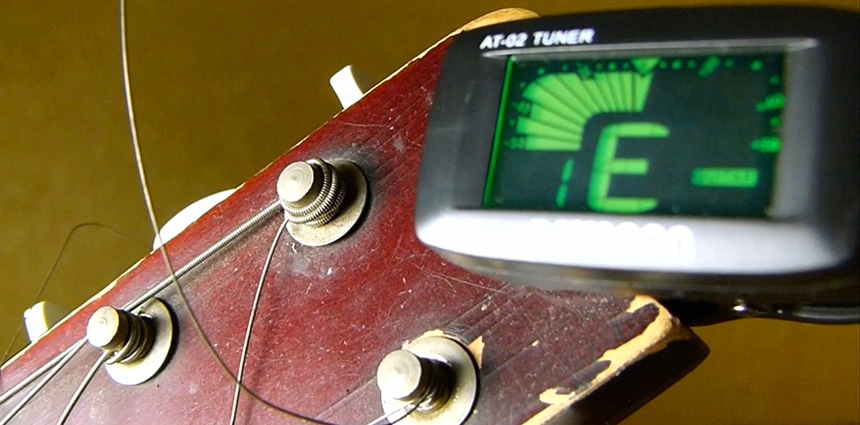The mandolin is a stringed instrument with four double strings Trusted Source Mandolin - Wikipedia en.wikipedia.org . The number and type of mandolin strings have varied over time and place. Still, today the predominant configuration is that of the Neapolitan mandolin, with four double strings tuned like the violin (sol-re-la-mi).
Stringing a mandolin is a process that confuses many beginner players. One of the difficulties is fitting the looped end of the chain onto the tail hook. Some mandolins have a cover on the tailpiece that you must remove to access the hooks. You will need to bend the looped end of the string at an angle, or it will constantly pop off as you try to secure it to the adjustment post. To make the process smooth, we will tell you how to change mandolin strings and what you will need to carry out the steps successfully.
Note that we are not teaching you how to install a string on a guitar while building from scratch. Most mandolins come with the strings installed. What we are teaching you is about restringing a mandolin.
Get a new set of strings. Replacing all the strings is always advisable rather than changing a bad one. According to most reviews, the most reliable model must be the EJ74 Phosphor Mandolin Strings from D’Addario. Its warm, bright and balanced tone makes it one of the most reliable options out there for mandolins.

Remove the old G strings. The standard tuning for a mandolin is GDAE, ranging from low strings to high strings. The tension of the strings holds the bridge in place. Do not remove all the old strings simultaneously, or you will have to reset and adjust the bridge. Replace the L strings and D strings, followed by the A and E strings. Loosen the G string tuning pegs, remove the strings from the pegs, and then remove the opposite looped end of the strings from the hook on the tailpiece.
Bend the loop of the new G string at a 45-degree angle. One trick is to hold the looped end of the string against the tip of a pencil and bend the loop toward the pencil. Hook the loop onto the tailpiece. Place the chain in its housing on the bridge. Pull the chain towards the nut and the tailstock and place the chain in its slot in the nut.
Thread the G string through the hole in the tuning peg. Wrap it around the adjustment post at a 90-degree angle. Leave some slack in the rope. Hold the chain with your right hand and turn the adjustment peg counterclockwise until the slack in the rope is removed and the chain is wrapped several times around the tuning post. Repeat the process with the other G chain and the two D chains.
Loosen and remove the two strings A and the two strings of E. Follow the procedure in step 3 to put new strings A and E on the mandolin. The only difference is that the pegs are turned to the right to tighten the strings rather than counterclockwise.
Pull up on the strings several times to stretch them. Tune the mandolin at a standard pitch with an electronic tuner. A variety of tuners are available at guitar and acoustic instrument stores. The number one bestselling music tuning accessory in online stores is the KLIQ UberTuner. This is a professional clip-on tuner that you can use for all types of instruments.
The mandolin is not the easiest musical instrument to tune. An old musician joke says that “if you’ve been playing the mandolin for thirty years, then you must have spent fifteen years tuning it and the other fifteen years playing it out of tune. Rest assured, it is quite possible to tune your mandolin correctly with a minimum of concentration or by using an electronic tuner.
The mandolin is tuned like a violin. Professional and beginner mandolins have eight strings that are tuned in pairs, two strings reproduce the same note. The open strings must produce SOL RÉ LA MI from the lowest note to the highest. Since there are eight strings, the result will be SOL SOL RÉ RÉ LA LA MI MI. If you hold your instrument properly, the highest note-reproducing pair of strings (E) is closest to the floor.
Identify the tuning keys. On most mandolins, the tuning keys corresponding to the two G strings and the two D strings face upward on the head when you hold your instrument properly. The tuning keys corresponding to the two A strings and the two E strings are facing down.

After tuning the A strings of your mandolin using an electronic tuner or another instrument as a reference, you will tune the D, G, and E strings.
Start by tuning a string. Tune an A string, then tune the second A string before playing both strings together. Tuning a mandolin is more difficult than tuning a violin is because on a mandolin there are eight strings Trusted Source How to Tune a Mandolin: 14 Steps (with Pictures) - wikiHow An old joke: If you’ve been playing mandolin for 30 years, you’ve spent 15 years tuning and another 15 years playing out of tune. While it’s true that it’s not the easiest instrument in the world to get in tune, it’s a perfectly manageable… www.wikihow.com instead of four on a violin and it is not clear which string is not properly tuned when playing two strings in unison.
To properly tune a mandolin, play both strings of the same note together, then muffle the tone produced by one string with your plectrum to isolate the tone of the other string. This will send a clear signal to your electronic tuner. If you are tuning by ear or using another musical instrument as a reference, do the same.
Here, you have to tune up. Stringed instruments are tuned by tightening the string (by raising the note) and not by relaxing it (by lowering the note). This allows the string to hold the chord longer while retaining its tension. You can, of course, tighten and relax the string to get close to the right note, but you must finish tuning a string by tightening the string. If you finish tuning by slackening the string, the string will quickly loosen, and your string will be out of tune again. If you are using new ropes, this practice is especially important. You may now have to change your strings, as explained earlier.
Tune your instrument gradually. After placing new strings on your mandolin, the instrument arm will move slightly with the strong tension of the strings. There is no point in trying to get precise tuning immediately, as new strings will quickly relax. Roughly tune your mandolin and let the instrument rest for a while before tuning it again, then let it rest again before fine-tuning the tuning. A guitarist’s trick is to pull the strings hard enough four or five times (not too hard anyway) at the soundhole by moving the strings away from the instrument’s body. Then tune the mandolin and repeat the operation three or four times.

The easiest and most efficient way to tune a mandolin is to use a quality electronic tuner. You can purchase an electronic mandolin tuner or a violin tuner since the strings reproduce the same notes.
Some electronic chromatic tuners can be attached to the instrument. If you rehearse a lot or play on stage, this type of tuner is of great use to you, as you leave it on the instrument, and you can tune your mandolin at any time. There is a wide variety of models. Inquire at a musical instrument store or by searching the internet.
Check if there is a battery in your tuner and turn it on. If you have purchased a tuner with different instrument options, set it to “mandolin” or “violin”. Tune your instrument in a quiet place, as your tuner’s microphone will pick up voices or other sounds produced in the room.
Play an open string. Tune each string one at a time. Turn the key corresponding to this string until the right note is produced. You don’t have to tune the strings perfectly yet; you’ll fine-tune your tuning afterward. Look at the needle or light-emitting diodes (LEDs) on your electronic tuner and tune all the strings by completing the tuning of each string by tensioning the string.
After having tuned all your mandolin strings for the first time, start again by refining the tuning to come as close as possible to perfection. Electronic tuners tell you if the note you are producing is too high or too low, and some devices have a blinking LED or green LED that lights up when the note is right.
If you have a few unanswered questions, the following will help you.
It’s always a good idea to change your mandolin strings regularly – about once in every 3 months or after every 100-hour of practice. This way, you will get a nicer tone, more responsiveness, and better dynamics. If you don’t properly string your mandolin, you may find that it’s hard to stay in tune and could even develop dead notes (notes that don’t sound on certain frets).
You have to choose an acoustic or electric string depending on the type of your mandolin. To begin with, you need to choose the diameter of the string that matches your style of music and your playing: this is called the string-puller. Remember to put on the same size or gauge strings as the ones being replaced. This will help the intonation. If you change the size of the strings, you’ll want to go to a guitar store and have a luthier (person who builds stringed instruments) set up or strobe the instrument to match the new strings.
The Elixir Strings Mandolin Strings is one of the best options for beginners looking for an inexpensive string set for less played mandolin. It has a NANOWEB coating and bronze wrap wire.

You can overstretch the strings too much if you’re not careful. Secure the strings to the acoustic guitar. Tune it up and as the string draws in tight, you will hear it coming up to pitch. In any case, you should know that the weaker the pull, the thinner the string and the easier it is to play.
Dirt, grime, and sweat build up on the mandolin strings over time, disturbing the tonal quality. On the other hand, new channels produce clearer and crisper sound, and they have several advantages. They sound better, hold their ground longer, and respond better to strumming, whether it’s with the left or right hand. The smooth surface of new strings also allows your fingers to slide over the strings with less resistance.
All mandolin players need to know how to professionally string your instrument. Mandolin strings, especially bottom strings, can easily break. However, even if only one string is damaged, changing your entire string set is best. By changing only one string, you will have a different sound on that string since the set is new, so your mandolin will sound different and unbalanced. The old strings and the new string would not sound the same at all, and the overall result would be a mix between old and new. The second thing to never do when stringing a mandolin is cut the strings suddenly. The tension is such that a rope jump could damage your eye or slash your face! You have to remove and then reassemble string after string so that the neck of your mandolin always remains under tension. Or you might end up with a mandolin that goes out of tune too often.